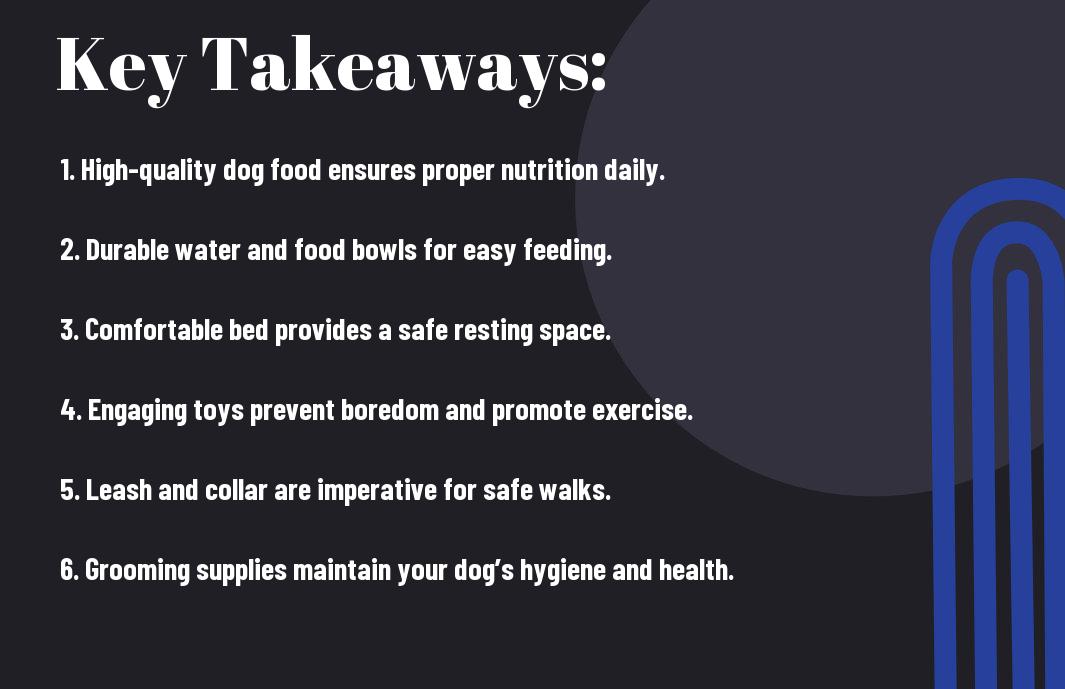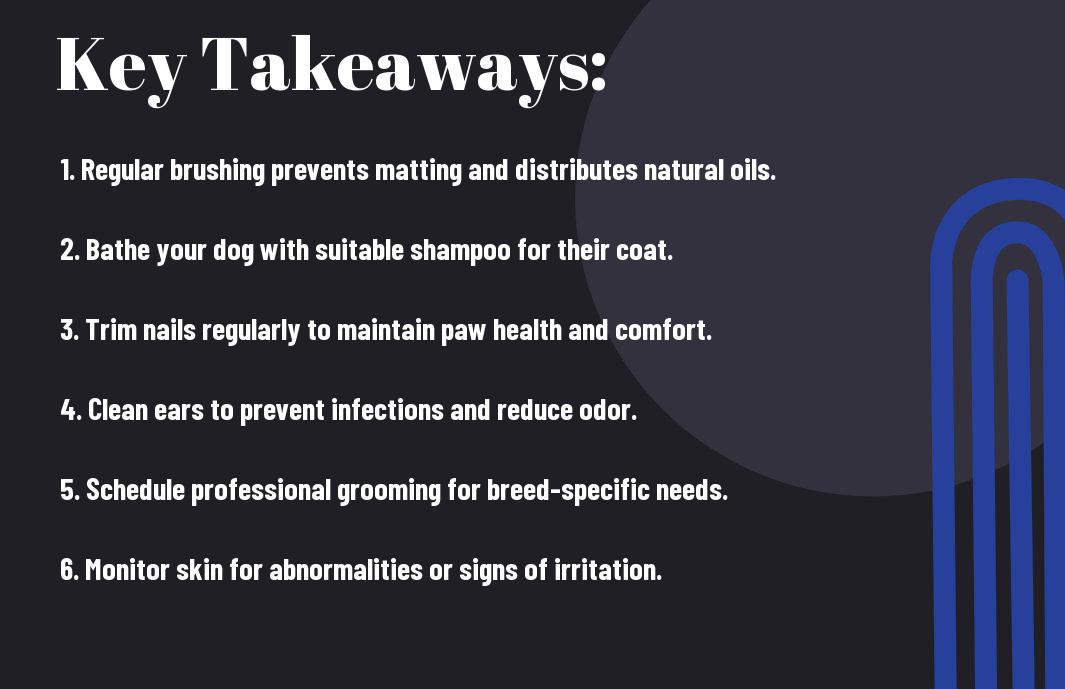It’s important for you to understand the many benefits of regular grooming for your dog. Not only does grooming maintain your pet’s hygiene, but it also allows you to monitor their health for any signs of skin issues or parasites. Keeping your dog’s coat free of mats and tangles can significantly enhance their comfort and overall well-being. Regular grooming sessions also promote a stronger bond between you and your furry friend, contributing positively to their emotional health. Prioritizing grooming is an investment in your dog’s happiness and longevity.

Understanding Dog Grooming
Your dog’s grooming needs are an crucial aspect of their overall well-being. It encompasses various methods and practices that help maintain their hygiene, appearance, and health. Regular grooming allows you to identify any potential health concerns early on, such as skin issues or parasites, ensuring your furry friend stays happy and comfortable.
Definition of Dog Grooming
Definition: Dog grooming is the process of cleaning, maintaining, and enhancing your dog’s coat and skin. This involves bathing, brushing, trimming, and other practices that promote a healthy and shiny coat. Grooming also includes nail trimming and ear cleaning, which are crucial for preventing discomfort and infections.
Alongside these physical aspects, dog grooming can also contribute to your pet’s emotional health. A well-groomed dog is often more comfortable, more sociable, and can enjoy a better quality of life. Regular grooming sessions can serve as bonding time between you and your dog, establishing trust and comfort.
Types of Dog Grooming
Around the world of dog grooming, there are several types that cater to the unique needs of your dog. Each type serves a specific purpose and varies in frequency and techniques used:
| Type of Grooming | Description |
| Basic Grooming | Includes brushing, bathing, and nail trimming. |
| Professional Grooming | Involves complex techniques for show dogs. |
| At-Home Grooming | Routine care performed by pet owners. |
| Health Grooming | Focuses on identifying health issues through grooming. |
| Specialty Grooming | Catered to specific breeds or coat types. |
The various types of grooming ensure that your dog receives the appropriate care based on their specific needs. Each style can impact their appearance and health in different ways, so adapting your grooming routine to your dog can enhance their overall well-being.
- Basic Grooming
- Professional Grooming
- At-Home Grooming
- Health Grooming
- Specialty Grooming
The understanding of these types will help you create a comprehensive grooming plan for your dog, ensuring that their specific needs are addressed. Grooming plays an integral role in both your dog’s health and your relationship with them.
Breed-Specific Grooming Needs
Grooming your dog may differ significantly from one breed to another. Each breed comes with its own set of grooming requirements based on its coat type, skin sensitivity, and unique characteristics. For instance, dogs with long hair, such as the Golden Retriever or Shih Tzu, may require more frequent brushing and trimming compared to short-haired breeds like the Pug or Beagle.
Understanding these breed-specific grooming needs allows you to tailor your grooming routine accordingly. This customized approach not only maintains your dog’s aesthetic appeal but also promotes their health and comfort. Improper grooming practices can lead to issues such as painful mats in long-haired breeds or skin irritations in those with sensitive skin.
It’s crucial to recognize that grooming is not a one-size-fits-all process. By learning about your dog’s particular requirements, you can avoid common grooming mistakes that may lead to discomfort or health issues. An informed grooming approach can keep your dog’s coat healthy and aide in their overall happiness, which is something every pet owner aims to achieve.
- Breed-Specific Needs
- Long-Haired Breeds
- Short-Haired Breeds
- Tailored Grooming Routine
- Health and Comfort
The adjustment in your grooming practices based on your dog’s breed will ultimately enhance their quality of life and strengthen your bond with them. In essence, understanding your dog’s breed-specific grooming needs is vital to ensuring a happy and healthy pet.

Benefits of Regular Grooming
For you as a dog owner, understanding the multiple benefits of regular grooming for your furry friend is vital. Regular grooming not only keeps your pet looking their best, but it also has significant effects on their overall well-being. By establishing a grooming routine, you can enhance your dog’s health, hygiene, and behavior, ultimately strengthening the bond you share together.
Health Benefits
At the core of good grooming practices lies the promotion of your dog’s health. Regular brushing helps to prevent matting, which can trap dirt, debris, and parasites close to the skin. This is particularly important for breeds with longer or thicker coats. Additionally, grooming can help you identify potential health issues, such as skin irritations, lumps, or ticks, early on, allowing for timely veterinary attention. Your dog’s coat and skin quality can also improve with regular grooming, as it enhances circulation and distributes natural oils that keep their skin healthy.
At the same time, maintaining your dog’s nails is also a vital part of their health. Overgrown nails can cause pain and discomfort, potentially leading to mobility issues or even injury. Regular nail trimming ensures your dog remains comfortable and can walk freely, making grooming an effective way to keep your pup active and healthy.
Hygiene Benefits
Health and hygiene are interlinked; regular grooming plays a large part in ensuring your dog stays clean and odor-free. Bathing your dog on a routine basis can help remove dirt, odors, and excess oils from their skin and fur. This not only helps your dog smell fresh but also keeps their skin free from irritations and infections caused by accumulated grime.
In fact, maintaining good hygiene through regular grooming also reduces the risk of skin infections. By regularly checking your dog’s ears, teeth, and paws during grooming sessions, you can spot any signs of problems before they escalate into more significant concerns. Ensuring that your dog is clean can contribute significantly to their overall well-being and happiness.
Behavioral Benefits
Any pet owner knows that grooming can have a positive impact on your dog’s behavior. Regular grooming sessions provide an opportunity for you to spend quality time with your pet, strengthening the bond and encouraging a sense of trust. This one-on-one time can significantly help with anxiety and stress levels, creating a calm and relaxed atmosphere for your dog.
Indeed, dogs that are groomed frequently often exhibit improved behavior, as they become accustomed to the handling and care involved in the process. You may find that your dog is more relaxed during vet visits or when meeting new people, reducing their overall anxiety and making social situations more enjoyable.
Grooming Tools and Supplies
Now, when it comes to maintaining your dog’s hygiene and appearance, having the right grooming tools is crucial. These tools not only help you keep your furry friend looking great, but they also promote their overall health by removing dirt, debris, and loose fur. Investing in quality grooming supplies will make the entire process smoother for both you and your pet, reducing any stress during grooming sessions.
Essential Grooming Tools
Among the must-have grooming tools, a good brush stands out. Depending on your dog’s coat type, you may need a specific brush, such as a slicker brush for long-haired dogs or a bristle brush for short-haired breeds. Additionally, a reliable pair of dog clippers is vital for those who prefer to trim their dog’s coat at home. Regular trimming helps prevent matting and keeps your dog’s coat healthy. Don’t forget to include nail clippers and a quality dog shampoo that suits your dog’s skin type in your grooming kit.
Optional Tools for Specific Needs
About some dogs, they may require additional grooming tools to cater to specific needs. For example, if your dog has a thick undercoat, investing in an undercoat rake can help remove loose hairs and prevent matting. Furthermore, dogs with long ears, like Basset Hounds, often need an ear cleaner to maintain ear hygiene. These optional tools can make a significant difference in the grooming experience and enhance your dog’s overall comfort.
Grooming tools tailored to specific needs can help you address potential health issues before they escalate. Using ear cleaners, for instance, can help prevent ear infections, especially in breeds prone to such conditions. Likewise, specialized brushes for each coat type can minimize shedding and improve your dog’s coat condition, promoting a healthy shine. By taking the time to understand your dog’s unique grooming requirements, you set the stage for a smoother, more enjoyable grooming routine.
Grooming Techniques and Best Practices
Not only does regular grooming keep your dog looking great, but it also promotes their overall health and well-being. Understanding the best grooming techniques allows you to effectively care for your pet, ensuring they are comfortable and clean. This guide will walk you through imperative grooming practices that can help you maintain your dog’s appearance and health.
Bathing Your Dog
Along with keeping your dog clean, bathing plays a significant role in eliminating dirt, excess oils, and allergens that can irritate their skin. You should bathe your dog every 4-6 weeks, depending on their coat type and lifestyle. Use a high-quality dog shampoo, specifically formulated to suit your dog’s skin pH, to avoid drying out their skin or causing irritation.
It’s important to make the bathing experience enjoyable for your dog; using warm water and positive reinforcement can help. While bathing, be cautious to avoid getting water in their ears and eyes, and thoroughly rinse all the soap out to prevent residue buildup, which can cause itching and discomfort.
Brushing Techniques
Before you start brushing your dog, take a moment to evaluate their coat type, as different coats require different brushing techniques. For example, short-haired dogs typically need minimal brushing and can benefit from a rubber curry brush, whereas long-haired breeds may require a specialized slicker brush to avoid matting and tangles.
Your goal should be to create a consistent brushing routine that suits your dog’s needs and prevents discomfort. Make sure to brush in the direction of hair growth, be gentle in sensitive areas, and reward your dog with praise or treats for their cooperation. Regular brushing not only helps remove loose hair but also promotes healthy skin and coat by distributing natural oils.
Your bond with your dog can deepen through grooming; it’s a way to give them focused attention while ensuring they feel comfortable and loved. Consistent grooming is key to managing shedding and reducing allergens in your home.
Nail Care
An often-overlooked aspect of grooming is nail care, which is vital for your dog’s comfort and health. Long nails can lead to discomfort, improper gait, and even injuries. Aim to trim your dog’s nails every 3-4 weeks, or more frequently if they’re more active and wear their nails down naturally.
But when trimming, be careful not to cut too close to the quick, which is a sensitive part of the nail that can cause bleeding and pain. If you’re unsure, start with just a small amount and use a file or grinder to smooth the edges. Make the experience positive by using treats and praise to encourage your dog to remain calm.
Ear and Teeth Care
Trimming your dog’s ears and cleaning their teeth are both integral parts of their grooming routine. Regular ear cleaning helps prevent infections caused by wax and debris buildup. You can use a veterinarian-recommended ear cleaner and cotton balls to gently wipe the outer ear flap and ear canal, ensuring your dog stays healthy and comfortable.
Grooming your dog’s teeth is equally important, as dental diseases can lead to severe health issues. Aim to brush your dog’s teeth at least two to three times a week with a dog toothbrush and safe toothpaste. Regular dental care can prevent plaque buildup, bad breath, and ensure your dog maintains a healthy smile.
Grooming your dog effectively will not only help enhance their appearance but also significantly improve their quality of life. Providing proper care for their ears and teeth, as well as their coat and nails, creates a happier and healthier pet.

Frequency of Grooming
For dog owners, understanding the importance of regular grooming is important to your pet’s overall health and well-being. Unlike humans, dogs cannot maintain their coat and skin on their own, which means it is your responsibility to ensure they receive the grooming they need. Neglecting grooming can lead to a range of problems, including skin infections, mats, and even discomfort for your furry friend.
Factors Influencing Grooming Frequency
Several factors can influence how often you should groom your dog. The first is the breed of your dog, as some breeds have a more demanding coat care routine than others. For example, long-haired breeds often require more frequent grooming to avoid matting, while short-haired breeds may only need occasional brushing. Additionally, your dog’s age and activity level can impact their grooming needs; puppies may have comparatively lesser grooming requirements, while active dogs may require more frequent attention to keep dirt and debris at bay.
- Breed: Different breeds require varying grooming needs.
- Coat Type: Certain coat types may necessitate more frequent grooming.
- Age: Puppies and older dogs might have unique grooming requirements.
- Activity Level: Active dogs may need more frequent grooming due to dirt and tangles.
Thou should consider all these factors when determining how often to groom your pet, as they play a significant role in promoting optimal health and comfort for your dog.
Grooming Schedules
Above all, establishing a grooming schedule tailored to your dog’s needs is important. A well-structured grooming schedule can help prevent potential health issues related to inadequate grooming. For many dogs, a grooming schedule can vary from once a week to several times a year, depending on their specific grooming requirements. Make it a point to monitor your dog’s coat condition and adjust your schedule as necessary, ensuring your pet remains comfortable and healthy.
Also, incorporating grooming into your dog’s routine can yield several positive benefits. Regular brushing not only helps maintain their coat but also allows you to check for any signs of skin issues, parasites, or abnormalities that may need attention. Moreover, getting your dog accustomed to grooming activities from an early age can reduce anxiety during grooming sessions as they mature. Establishing a consistent schedule promotes a positive grooming experience for you and your pet, fostering that important bond while keeping your furry friend looking and feeling great.
Overcoming Grooming Challenges
All dogs come with their own unique set of grooming challenges, and as a responsible pet owner, it’s crucial to address these effectively. Regular grooming not only keeps your dog looking great but also ensures their health and happiness. Overcoming grooming challenges can strengthen your bond with your furry friend and make grooming a more enjoyable experience for both of you.
Common Grooming Issues
Between tangles, shedding, and sensitive skin, grooming challenges may frequently arise during your dog’s grooming sessions. Some dogs may be particularly sensitive to noise, making them anxious when you use clippers or brushes. You may also encounter behavioral issues, like your dog resisting or becoming fidgety during grooming, which can make the process more stressful for both of you.
Additionally, certain breeds are more prone to specific grooming issues. For example, long-haired breeds are susceptible to mats and tangles, whereas short-haired breeds may require more frequent shedding control. Recognizing these common grooming issues can help you prepare better and set realistic expectations for your dog’s grooming routine.
Solutions and Tips
Any dog can be groomed with the right approach and preparedness. One of the best ways to tackle grooming challenges is to start early with your dog. Gradually introduce grooming tools to build their comfort and trust, ensuring that they associate brushing and bathing with positive *experiences*. You can also create a pleasant grooming environment by choosing a quiet, cozy space free from distractions.
- Use positive reinforcement to reward your dog for good behavior during grooming.
- Choose grooming tools that are suitable for your dog’s coat type to minimize discomfort.
- Establish a regular grooming routine to help your dog adapt and become more comfortable over time.
Furthermore, ensuring that your dog is well-exercised before grooming can help curb any excess energy, making the session smoother. It’s vital to keep an eye on their sensitivities and adjust your techniques accordingly. Pay attention to your dog’s cues and responses during grooming to minimize their stress and anxiety.
- Maintain a calm demeanor and speak reassuringly to your dog during grooming sessions.
- Incorporate breaks if your dog becomes anxious or restless.
- Consider seeking a professional groomer if you encounter persistent issues that you feel uncomfortable handling yourself.
The key to overcoming grooming challenges lies in patience and understanding your dog’s unique needs. Developing a solid plan and adapting as needed will benefit both you and your furry companion, leading to a more enjoyable grooming experience.
Conclusion
Now that you understand the importance of regular grooming for your dog, it’s clear that this routine goes beyond mere aesthetics. Incorporating grooming into your dog’s regimen can significantly enhance their overall health and well-being. By keeping your dog’s coat clean and detangled, you can prevent skin irritations and matting that may lead to discomfort or health issues. Regularly checking your dog’s ears, teeth, and nails can also catch potential problems early, allowing you to address them before they escalate.
Additionally, grooming sessions can serve as an excellent opportunity for bonding with your pet. You’ll be able to establish trust, making your dog feel secure and loved. By maintaining a consistent grooming schedule, you not only ensure a healthier and happier pet but also create a routine that can contribute to a strong, positive relationship between you and your furry friend. Investing time in grooming can greatly enhance the quality of life for your dog and enrich your shared experiences.
Q: Why is regular grooming important for my dog’s health?
A: Regular grooming plays a significant role in maintaining your dog’s overall health. Firstly, it helps to keep your dog’s coat clean and free from debris, dirt, and parasites such as fleas and ticks. Secondly, consistent grooming allows you to check for any unusual lumps, bumps, or skin conditions that may require veterinary attention. Additionally, it facilitates better circulation in the skin and helps in distributing natural oils, which can promote a healthier coat.
Q: How often should I groom my dog?
A: The frequency of grooming depends largely on the type of coat your dog has. For example, long-haired breeds may require grooming several times a week to prevent matting and tangles, while short-haired breeds typically need grooming less often—around once a month—especially to control shedding. Regardless of the breed, a good rule of thumb is to assess your dog’s coat condition regularly and groom as needed to maintain cleanliness and comfort.
Q: What are some grooming practices I should include in my dog’s routine?
A: A comprehensive grooming routine should include several practices. Start with regular brushing to remove loose hair and prevent matting, then bathe your dog with appropriate shampoo to keep their coat clean. Nail trimming is also important to avoid overgrowth, which can lead to discomfort. Additionally, don’t forget dental care, as regular tooth brushing can prevent dental disease. Finally, routine ear cleaning helps avoid infections, especially in breeds prone to ear issues.










